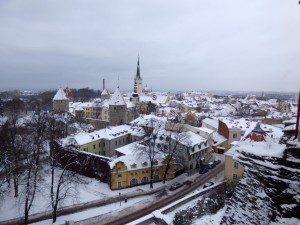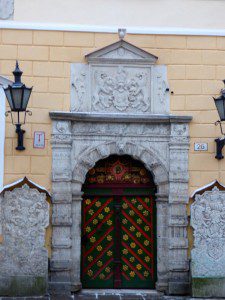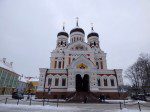Dancing in Tallinn

Imagine the scene: It’s a snow-covered square surrounded by faded remnants of Tallinn’s rich past. Snow is gently falling. And in the midst of this there’s a group of 20 Australians, Spaniards and Mexicans doing a traditional Estonian dance – very badly.
We learnt a lot about Estonian history today. Here are some highlights:
1. Tallinn claims to be the place marzipan was invented. It’s not alone in making that claim. Regardless of the accuracy of the claim, marzipan has been made here for a very long time, and they are very good at making it. We visited the Marzipan Museum in the morning: Truth be told it isn’t much of a museum – partly because 60-year-old marzipan just looks pretty unappetising. It does, however, have a beautiful coffee shop attached which does a great line in marzipan cake.
 2. Estonia is currently in the longest period of independence in its entire history – 23 years. This area has been claimed and fought over by foreign powers since it was first settled. It was disturbingly recently that ‘extreme serfdom’ was abolished – a system which allowed the German landowners to treat the local Estonians pretty much as slaves.
2. Estonia is currently in the longest period of independence in its entire history – 23 years. This area has been claimed and fought over by foreign powers since it was first settled. It was disturbingly recently that ‘extreme serfdom’ was abolished – a system which allowed the German landowners to treat the local Estonians pretty much as slaves.
3. At the end of WW2 the Soviets decided to bomb Tallinn. Not for strategic reasons, the Germans had already pulled out, but because it would cow any incipient nationalism amongst the Estonians. They did in fact bomb the city but the old town was largely saved because, by chance, the date chosen for the attack was International Womens Day. As a result of the Soviet pilots celebrating women, they were all too drunk to do much of a job of bombing, or of noticing the Finnish airforce planes that joined the returning air wing and bombed their airfield to smithereens.

4. No matter how entertaining your guide is – and we had a brilliant guide – two hours of walking tour in sub-zero temperatures makes for a very, very cold group. Hot chocolate will put you right though.
5. About 30 percent of Estonians identify themselves as Russian. They speak Russian as their first language, read and watch Russian media and are to intents and purposes Russian – although they have Estonian passports. According to our guide they end up confused, and then go and get jobs as programmers in London.
6. From the 1400s Tallinn was defended by the Brotherhood of the Blackheads. The Brotherhood can claim that they were responsible for the first public Christmas tree in Europe; which they erected in the town square in 1441.
7. Somewhat in parallel with current affairs, in the 1930s the Soviets offered to protect Estonia from the Germans or the Soviets would invade. The Estonians had little choice but to accept the offered help. In elections to ratify Estonia becoming part of the Soviet Union 80 per cent of the population turned out to vote – the result was published as 97 percent of the population voting ‘yes’. The Estonian resistance was bolstered by Finns – not soldiers, just volunteers who happened to have government weapons.
8. The Estonians did have a resistance group during the war, called the Forest Brothers. They continued to form an increasingly ineffective resistance after the War with the last Brothers remaining in hiding and evading capture into the 1980s.
9. During the 70s and 80s punks, complete with mohawks and tattoos, would gather on a hillside above the old town and exchange vinyl records from the West – a crime punishable by imprisonment. They chose the hill so they could see any approaching police. If the police did approach, the punks would quickly hide the records and pull out stamp albums instead – which must have been a particularly strange sight.
10. Estonian traditional dancing is an activity probably not best done while freezing cold and bundled up like the Michelin Man. Fun, though.


